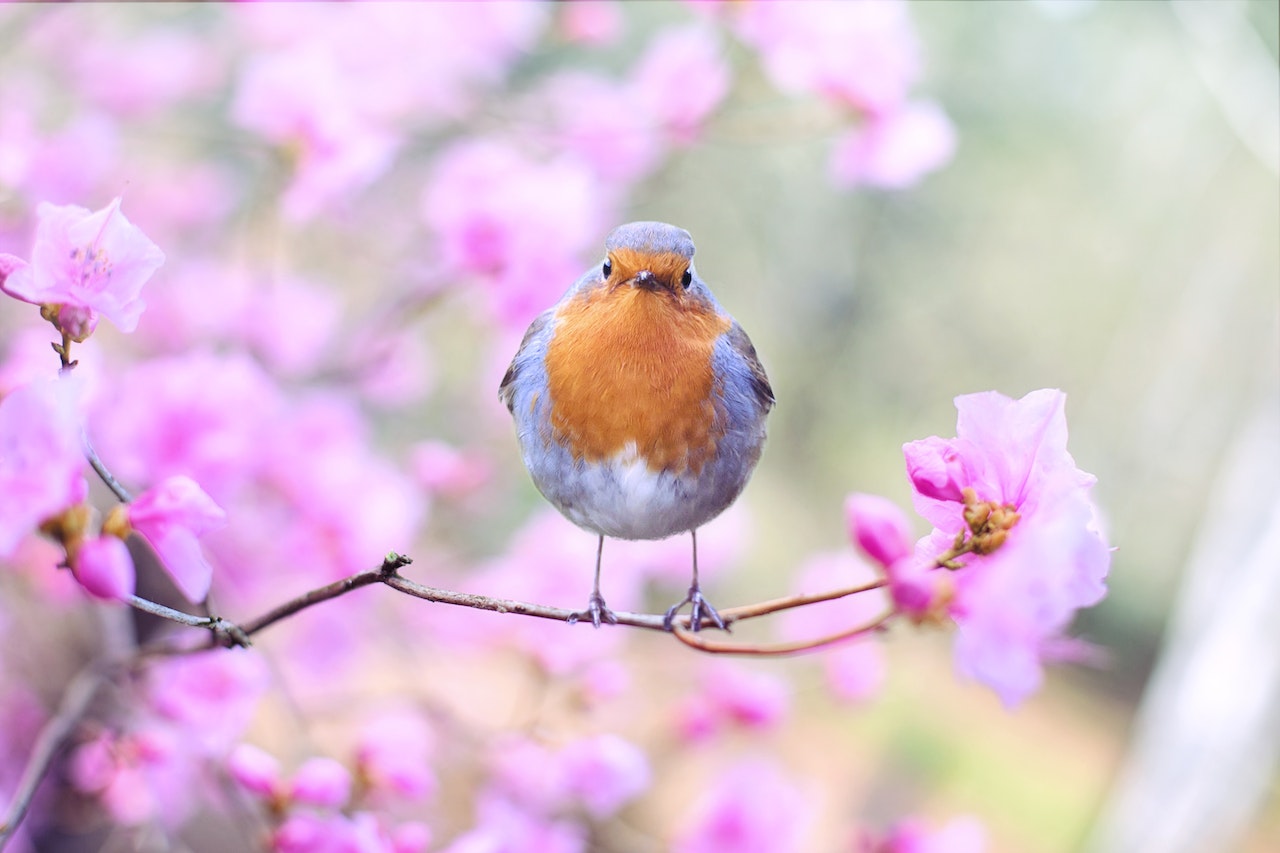Health WellNews
Fun Things to do this Spring

The dawn of Spring is a glorious time of year as the air is warmer and the days are longer. Fresh food and fresh flowers are all around us and now that it’s more comfortable to be outside again, there are several fun activities to enjoy both indoors and outdoors this Spring. Which one(s) will you and your family enjoy?
If you really sit down and think about it, your Spring activity list could include just about any adventure you can think of. Here’s an initial batch of ideas if you absolutely can’t wait to get back outdoors. If you live in the right part of the country, go see the cherry blossoms! It really is a remarkable site so if you can do this you definitely should. It’s also the perfect time to:
- Plant a Spring garden.
- Have a picnic at the park.
- Join that hiking club you’ve been thinking about since last year.
- Join a running club or a softball league.
- Join the craze and hit the pickle ball court.
- Take up golf (or mini golf if that’s more your speed).
While not an exhaustive list, the one above can get you started. Here’s another list of ideas for some Spring activities if you have kids…or even if you are simply a kid at heart.
- Go fly a kite (for real, not just an expression).
- Find a playground and play on the swings or the merry go round.
- Feed the ducks at the local pond.
- Wade in a creek and climb a tree.
- Blow bubbles.
- Draw pictures on the sidewalk with colored chalk.
Now that we have a few activities to consider, what to eat is also a big topic come Spring. The possibilities for fresh fruits and vegetables are amazing at this time of year. Enjoy some roasted asparagus, artichokes, new potatoes, spinach, sugar snap peas, and carrots. It’s also the perfect time of year for fresh strawberries and apricots. If you live on the East Coast, it’s also soft-shell crab season. And, with Easter around the corner, don’t forget to enjoy jellybeans and Peeps!
And there are just some activities that we can really appreciate more in the Spring after a long and harsh winter. For example, open the windows and let the fresh, clean air in and listen to the rain on a Saturday morning. Look for rainbows and head outside in your bare feet to enjoy the sun on your face. Decorate your house with fresh flowers and break out the Spring wardrobe of vibrant colors and open toed shoes!
The cold and dark days of winter are behind us, and the bright days of Spring are here. Get off the couch and get back outside; it’s great for your mental and physical health. Spring is a beautiful time of year when the earth wakes up from its winter slumber. Get outside and enjoy all this glorious season has to offer…before it’s too hot to be outside!
5 Ways to Stay Fit This Winter

As the weather worsens and the colder months are upon us, it’s important to make sure we don’t continue the overindulgence of the holidays. While there is nothing better than comfort food when it’s cold outside, we can’t let that lead to gaining winter weight and letting our health slide. With just a little planning and some accountability, you can maintain your fitness (and maybe even improve it!) this winter. Just follow these five tips to get you going in the right direction.
Challenge Yourself
There are fitness apps galore with any number of winter fitness challenges (some free) you can sign up for, no matter what your fitness level. These challenges give you a sense of accountability and accomplishment as you stick with it for 30 days to reach a predetermined goal. Whatever your interest (walking, swimming, squats, lunges, etc.) you can find something of interest to keep motivated. And better yet, grab a friend or two to join in. Making it a social occasion means you are more likely to stick with it and the extra accountability helps, too!
Get Outside
Even with the colder temps, it’s important to get some outside exercise time, even if it’s just a simple walk in the neighborhood. If you developed a habit of taking an evening walk in the summer, you might need to adjust that as the days are shorter and it might be too cold at night. Outside exercise helps you get fresh air and exposure to natural light which helps to regulate your circadian rhythm.
Track Your Steps
If the kids were out of school and your family took some time off your normal routine, it can sometimes be difficult to get back on track. An easy way to get yourself going again is to track your activity levels. Most cell phones and smart watches and fitness bands can help track everything from your steps to flights of stairs, to miles walked/biked/swam, to your sleeping habits. Tracking your activity level can help you be more conscious of how much physical movement you are doing during the day and keep you on track to make sure you are hitting your fitness goals.
Use What You Have
Warm blankets and your couch might have a greater pull in the cold winter months. However, don’t succumb to the temptation! And you can use what you have in your home to help you stay active. When watching your favorite television show, use the commercial breaks to squeeze in some cardio or stretches. Grab a band or hand weights and do some arm exercises while you wait for the show to resume. You can also try some yoga right from your couch! Or use a kitchen chair to get some light exercise in after dinner. Again, there are fitness apps to help with ideas and proper positioning.
Enjoy Winter’s Bounty & Stay Hydrated
Another easy addition to your winter routine is to change up your diet to include the winter harvest of vegetables and fruit. Peruse your farmer’s market and take advantage of the apples, pears, sweet potatoes, and varieties of squash that are plentiful this time of year. Staying hydrated also needs to be a priority. Winter air can be dry and if it’s cold, water might not be your first choice. Don’t be afraid to mix it up with herbal teas, coconut water, hot chocolate or kombucha. Try to limit your caffeine intake as that can dehydrate you, but if you need a pick-me-up, try green tea or white tea instead.
Don’t let the winter months take you down the wrong path! Keep those good habits going to get back on track in the new year and enjoy a healthy and active winter season!
4 Budget Friendly Family Activities

Depending on where you live and the weather you experience, winter can be a challenging time for families. It can be equally hard for kids and adults to be cooped up inside during the winter. Below are five budget friendly and even kid friendly activities you can do during the winter to keep boredom at bay and connect with each other.
Enjoy the Holiday Lights
In almost every town in America there is “the Christmas Street.” You know, it’s the one where it seems that the whole block decorates in coordinating themes for Christmas. Some towns even have elaborate displays in the downtown area or in a local park. Ask around to find the best place to view holiday lights. Bundle up the kids, grab some hot chocolate and take a drive around your neighborhood or town to see all the brilliant light displays. It costs little money, and you might just find yourself establishing a new family tradition!
Game Night
If the weather is just too frightful, set up regular game nights. Let a different member of the family pick the game each week, make an easy dinner (or order in), turn off the electronics and enjoy! You might just find out some mild-mannered members of the family are actually very competitive. And if you have kids, you can easily use these opportunities to teach problem solving skills or improve their vocabulary or teach them teamwork. In addition to board and card games, puzzles are also a great activity and if you really like the finished product, have it framed and hung on your wall.
Cook Together
Another great family activity is to cook together if it’s just too cold to be outside. Let each family member pick a meal to help prepare during the week or on the weekend. Each family member can make their list of ingredients, help with the shopping, and then prepare the meal (with the proper supervision if the kids are little, of course). Those who do not help to prepare the meal can be on clean-up duty, so everyone is helping, and one person isn’t stuck doing all the work!
Local Events
Another great way to add a little variety is to keep an eye on any winter festivals or local events in your area. For many of these events, kids can go for free, keeping costs down for the whole family. Free sleigh rides to face painting to rides and games, you never know what you might find and it’s a great way to keep up with what’s happening in your community. You may even make some new friends while out and about!
Bonus Tip
Think about volunteering in your community, which typically only costs your time and is a great way to model giving back to any kids in your orbit. Depending on where you live and your interests, you might volunteer at a soup kitchen, food bank, animal shelter, library, etc. Check with the city where you live and see what opportunities might be available.
Staying Healthy This Winter

The winter months can be a challenge if you just can’t stay healthy. Staying indoors and being near people can allow for the spread of unwanted germs. This can increase your chances of catching a variety of illnesses including flu, colds, or even the dreaded Covid-19 and its variations. Following just a few important steps can help keep you and your family healthy so nobody misses out on the fun the season can bring.
Just by washing your hands frequently you can protect yourself and prevent the spread of various illnesses. Regularly wiping down surfaces with a sanitizing cleanser and keeping your distance from those you know are sick also helps. Additional tips include staying hydrated and flushing toxins out of your system, getting enough sleep to keep your immune system in good shape and avoiding touching your eyes, nose, and mouth to avoid catching anything that might be going around.
Make Good Choices
Don’t fall into the “comfort food” trap of eating for comfort all the time and foregoing proper nutrition. Indulging occasionally is not a problem but getting into a spiral of unhealthy eating can only lead to bad choices and health consequences. Make sure you enjoy a diet of winter’s best vegetables, fruits, lean protein, and whole grains. Keep an eye on portion size as well.
Active in Mind & Body
Shorter days and cold temperatures can make it hard to get moving. The temptation to stay in and stay warm is strong! Make sure you engage in regular physical activity and keep an eye on your mental health as well. It’s important to engage in regular physical activity to reduce anxiety, lower your blood pressure, improve your sleep quality, and maintain or lose weight, depending on your goals. Regular exercise also helps keep your mental health in check. Incorporating regular breathing exercises and meditation is also a great idea.
Winter months can be difficult for some but having a plan to keep your body moving and your mind strong is a great way to thrive this winter and set yourself up for a fabulous Spring!
Seven Healthy Fall Habits

Fall is a great time to reset after a busy summer season. If you established some healthy habits this summer, you definitely want to keep them going to keep your immunity strong as the season changes.
Habit 1: Make sure you moisturize to keep your skin healthy as the weather gets colder and dryer. If you aren’t careful, your skin can crack and chafe which can lead to infection if not treated properly and early on. Anytime after a shower and throughout the day, make sure you use a moisturizing lotion to keep your skin healthy and glowing.
Habit 2: As we head into the holiday season, focus on your financial wellness so you can maintain financial stability and keep your spending habits under control. It could be as simple as a quick check of your accounts but if you are unsure of your financial health, seek out a financial planner or advisor. There are also free tools online that can help you set up a budget and track your spending and your savings.
Habit 3: It’s easy to fall into a trap of gravitating to only those rich and sometimes unhealthy comfort foods as the weather gets cooler. Make sure you are consuming healthy food by taking advantage of all the fall produce available.
Habit 4: Self-care is a must! Make yourself a priority so you can stay refreshed and ready to give your best to your friends and family. This looks different for everyone so give yourself the space to find what works for you. It could be an evening or morning walk, journaling, or having time to read or enjoy another hobby. Whatever it is, carve out the time to do it.
Habit 5: The lack of sunshine that can come in cooler climates can make our Vitamin D levels plummet. Consider adding a supplement to your diet if you find yourself running low. Talk to your health care provider about ways to incorporate more Vitamin D into your diet.
Habit 6: The cooler temperatures that come with fall can open up a wide variety of activities that you just couldn’t fully enjoy during the hot and steamy summer months. Hiking, apple picking, biking, or even just yard work can all get you outside and get your heart rate up. Stay active to boost not just your physical but your mental health as well!
Habit 7: Another great way to get yourself on track heading into the fall is to get those health appointments scheduled. Make sure you get that eye exam and those physicals scheduled so you can keep yourself on track heading to the holidays and you aren’t waiting until something is wrong or trying to squeeze in a visit during the busy holiday season.
Start with one habit and then begin to incorporate the rest and you will feel better than ever this fall!
5 Ways to Stay Fit This Fall

If you are on a fitness roll this summer, you don’t want to “fall” back into old habits (pardon the pun). As the weather gets colder, you might find it challenging to maintain the same fitness routine. Or maybe you took the summer off, and you are ready to kick off a fall campaign to get in shape. Whatever your goals or motivations, here are five tips to keep you on track.
You may be a morning workout person in the summer as you try to beat the heat, but you might need to rethink that as the weather gets colder and the days get shorter. Try an after-work workout to see how you adjust and which one feels better. Pay particular attention to what makes you feel more energized. If you are so tired after a morning workout that you find it difficult to make it through the day, then perhaps you should go for an evening routine. But make sure you can still fall asleep after an evening workout. Once you determine which time of day works best for you, stick to a routine to maintain your results.
Another great tip is to take advantage of the cooler temps to enjoy more outdoor activities like hiking, biking, walking, or running. Incorporate some weekend hikes or just an after dinner walk around the neighborhood a few nights a week. It doesn’t have to be complicated or expensive, just get outside and move!
While you may find yourself motivated to get started or keep your fitness routine going, make sure you set realistic expectations. It’s about progress and not perfection. Setting your expectations too high can set you up for failure so give yourself some grace and know that some days, the weather may not cooperate.
Another great way to keep motivated is to take advantage of all the great fall produce to help fuel your body as you set this new pattern of fitness routine. Nutrition is a key piece of the puzzle so load up on all the great fall fruits and veggies.
Another key piece of advice is to keep some at-home workouts in your back pocket. The weather won’t always cooperate and sometimes you just won’t feel like going out early or making that after work workout a reality. Another way to set yourself up for success is to create a few living room exercise routines. There are dozens, if not hundreds, of workout apps and YouTube videos that can help you maintain your fitness goals while at home.
Whatever you do, just make sure to keep moving! While it might be tempting to curl up under a warm blanket, Netflix and chill, make sure you are incorporating your fitness goals into your day so you can maintain the fitness wins you achieved this summer.
Improve Your Mental Health with Regular Meditation

Meditation has a reputation for several health benefits but what is it exactly? It is defined as the regular process of training your mind to focus and redirect your thoughts. There are some key reasons you might want to consider establishing a regular meditation routine. The overall improvement in your health and wellbeing just might surprise you.
Research proves that meditation can really be a stress reducer. Too much stress in your life can cause sleep issues, depression, anxiety, and even high blood pressure. An 8-week study published in 2013 found that “mindfulness meditation” actually reduced the inflammatory response caused by too much stress.
As mentioned previously, as stress levels decrease, so does anxiety. A 2014 study examined the transcendental meditation technique and found that it reduced anxiety significantly. However, that’s not the only technique that reduces anxiety. Additional research has found that a variety of techniques can reduce anxiety levels. It doesn’t matter what technique you try, just get started!
After the pandemic, we all know just how important it is to maintain our mental health. Regular meditation has been shown to reduce the symptoms of depression by decreasing the levels of inflammatory chemicals called cytokines, which are released in response to stress. It can also help people experience fewer negative thoughts.
Studies also show that regular meditation practices can lead to enhanced performance on visual tasks and a greater attention span than those who don’t regularly practice meditation. And you don’t need to set a goal of meditating for hours on end. Other studies have indicated that even short periods of meditation each day can be a benefit.
And, in case you haven’t noticed yet, each of these benefits just continues to cascade to additional benefits! Now that you know that regular meditation can lead to improvements in attention and clarity, you might be happy to hear that both benefits lead to keeping your mind young and healthy overall.
Studies have found that in addition to fighting the normal age-related memory loss that comes from getting older, meditation can at least partially improve memory in those suffering from dementia. It can also help to control stress and improve coping skills in caregivers.
Even the Mayo Clinic touts the benefits of meditation. They also outline the different types including guided meditation, mantra meditation, mindfulness meditation, Qi gong, tai chi, transcendental meditation, and yoga. They also advise that meditation takes practice, and you will get better at maintaining your focus and breathing the more you engage in the practice.
The bottom line is that meditation is something that everyone can try to improve their mental and emotional health. You don’t have to have a particular level of athletic ability; it doesn’t require a special location or equipment and you don’t have to buy a membership at a gym to try it. A simple Google or YouTube search can get you started. Trying out a variety of styles to see what might work best for you is a great way to begin your meditation journey.
Staying Active and Healthy in the Warm Summer Months
After the cold winter and unpredictable Spring weather we’ve been having, everyone is ready for a warm summer with longer days filled with rest, vacation, and family time. However, the warmer temperatures can often bring unanticipated health risks like seasonal allergies, heat stroke, and bug bites. Read on for a few tips to keep you not only active, but healthy as you embrace those dog days of summer.

Get Moving!
The summer months are a great time to get outside and get moving, especially if you live in a climate that doesn’t allow you to get out much during the winter and early spring months. That additional physical activity can lead to healthy hearts and maybe a trimmer waistline. As the temperatures heat up, it might be tempting to stay inside and enjoy the air conditioning but don’t fall for an all or nothing trap! If it gets too hot in your area, take a walk or an early morning bike ride before the heat is unbearable. If early mornings aren’t your thing, try a late evening stroll to get a little extra fitness in your day.
If you are lucky enough to live near the ocean or close to national parks, then hiking and biking on those gorgeous trails should be on your summer to-do list. A jog along the beach or an ocean swim are also great options. And don’t forget, your body isn’t the only thing that will benefit from the increased physical activity, your mind with thank you as well. Exercise is a great way to boost your mental health and improve your sleep.
Don’t Forget the Sunscreen
While getting outdoors is great, it also comes with risks. Too much UV light from the sun can be hazardous to your health, contributing to skin damage and increased cancer risk. Too much UV exposure can lead the skin to lose elasticity, get deeper wrinkles, and contribute to an overall premature aging of the skin.
To protect yourself, make sure you choose a broad-spectrum sunscreen that blocks both UVA and UVB rays and with a sun protection factor (SPF) of at least 50. And make sure you reapply your sunscreen after swimming or sweating. Getting outside is great for your mental and physical health but not if you burn in the process!
Stay Hydrated
In addition to sun protection, it’s important to make sure you are consuming plenty of fluids in the warmer temperatures. It might be tempting to indulge in those fruity alcoholic drinks, but they are not effective against dehydration, and neither is caffeine. They make it more difficult for the body to stay properly hydrated because they increase the body’s fluid output. Chronic dehydration can lead to serious complications such as kidney failure and shock.
Signs you might be dehydrated include:
- Dry mouth
- Headache
- Dizziness
- Muscle cramps
- Little or no urination
Saying healthy and active is definitely doable over the summer with just a little bit of planning and awareness. So, get outside and enjoy these long, warm days while you can!
Planning the Perfect Summer Vacation
It’s that time of year when the perfect summer getaway is within reach. Whether you are looking for a beach vacation or a mountain retreat, it’s never too early to begin researching the perfect summer vacation. Here are a few suggestions to get you started and ensure a successful and relaxing trip!

Book Early vs. Last Minute Deals
The summer season is often the peak vacation time for many destinations so if that’s the case with your preferred location, you might want to book early to take advantage of any flight, hotel, or rental car deals. Set alerts or, if you can be flexible, fly during non-peak times during the week as opposed to the weekends. You can also set alerts for your preferred hotel company or join their loyalty program to take advantage of any offers there.
While planning ahead can be a great way to score a deal before prices rise, sometimes leaving a little wiggle room for any last-minute deals can score even bigger savings. Venues might offer discounts for unclaimed tickets or cancellations. Don’t be afraid to ask about any sales or promotions. It’s always best to keep your options open!
Get Family Buy-In
You might have grand plans about a Hawaiian beach getaway, while the rest of the family is thinking theme park extravaganza. It’s important when planning a family vacation that you get buy-in from everyone on the location and itinerary. Make sure you include activities for each member of the family and get everyone involved in the planning process. When everyone is excited and looking forward to going, you won’t have unexpected battles to fight down the road. Pro tip: If you have kids, keep them busy wherever you go! From activities to keep them busy on the flight to daytime fun when you reach your destination, you want to make sure the kids are active enough to have fun and be ready for bed when the day ends.
Less Stress, More Relaxation
Everyone in your family may have a different idea of what a stress-free and relaxing vacation looks like. Some people like to pack every minute full of activities as they explore a new place while others want to lie on the beach or by the pool all day every day. No matter what your speed, plan some time to relax and take in your surroundings.
And definitely don’t add unnecessary stress to your vacation. If flying is too much for your family, consider a road trip. If getting to the airport is the most stressful part of the trip, consider a ride share option so you don’t have to worry about parking. Also, check your credit card rewards to see if you have access to an airport lounge. A lounge is a great way to relax before a flight.
And the most important advice is to enjoy the experience and make memories with your friends and family no matter where your trip takes you.
Healthy Choices for a Healthy Spring
After a long cold winter, Spring is a time for renewal and growth. The flowers and trees begin to bloom once again and the grayness of winter transitions to the brightness and warmth of Spring. If you have struggled to keep those New Year’s resolutions going, Spring is a great time for a fresh start with healthy choices. Here are a few tips to keep you and your family healthy and ready to enjoy the longer days of summer that are just around the corner.

Freshen Up Your Fitness Routine
If your fitness routine didn’t get off to a great start in the new year, it might be time to shake things up a bit as you head into Spring. With warmer temperatures and longer days, rethink how you approach your fitness plan and look at it as a chance to have some fun. Sign up for a 5k or join a weekend softball or basketball league. Pickleball and tennis are gaining in popularity across the country as well. And if a team sport isn’t your cup of tea, try hiking, biking or swimming.
Freshen Up Your Diet
Spring fruits and vegetables are coming back into season, so this is a great time to choose unprocessed whole foods rather than those full of sugar and preservatives. Avoid foods with corn syrup, dextrose, and fructose. If you are prone to afternoon snacking, choose raw foods like nuts, carrots, zucchini, or broccoli. Spring fruits and veggies are loaded with fiber, vitamins, and other nutrients so hit that farmer’s market and stock up on the bounty of options.
Freshen Up Your Me Time
Whether single or married, kids or not, it is important to schedule some “me” time and make it a priority, just as you would a doctor’s appointment. And it doesn’t have to be a long time and it doesn’t have to be complicated. It could be something as simple as a morning walk before work with a good cup of coffee in hand. Or it could be a hot soak in the tub with a glass of wine and a good book. Or it could be time spent in the garden after a long day of sitting at your desk. And if you try something you thought would nourish your soul and it doesn’t, don’t be afraid to try something else.
Freshen Up Your Social Life
Use these longer days to connect with people in your life. Schedule game nights, movie nights, walks, hikes, or happy hours to enjoy time with family and friends. Force yourself to do a digital detox and put down the phone, tablet, or laptop and step away from social media. Other ideas include volunteering, getting involved in a new hobby or sport are great ways to meet people and connect in new communities.
Bonus Tip
Another great tip is to make sure you are getting enough sleep every night. It is best for adults to get at least seven hours of sleep per night. Establishing all these healthy habits in Spring can set you up for a great summer and beyond.